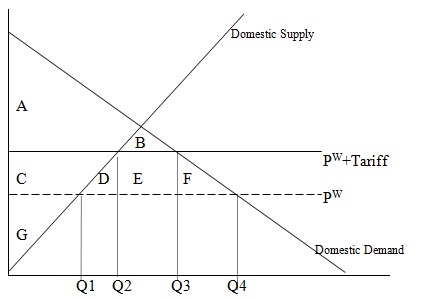Problem 1: Consider the local market for beef. Supply and demand curves can be represented as:
p = qs
p = -2qd + 15
1.1. What is the equilibrium price and equilibrium quantity?
1.2. Find the Total Revenue of the farmers
1.3. Now, suppose that Congress decides to put a price floor of $4 per pound of beef. How will the quantity demanded respond to this government intervention?
1.4. Now, suppose that Congress decides to put a price floor of $6 per pound of beef. How will the quantity demanded respond to this increase?
Problem 2: Consider the case when a government imposes a price ceiling in a market. Say if the following statement is true or false: “ the greater the elasticity of the demand curve, the greater the shortage in the market”. Sketch a graph comparing a more elastic demand curve and a relatively inelastic demand curve in order to see the results.
Problem 3: Please, refer to the graph below where pw is the world price:

3.1. If free trade is allowed, consumer surplus is the area:
a) A
b) A+B
c) A+B+C
d) A+B+C+D+E+F
e) A+B+C+D+E+F+G
3.2. If a tariff is placed on this good, consumer surplus is the area:
a) A
b) A+B
c) A+B+C
d) A+B+C+D+E+F
e) A+B+C+D+E+F+G
3.3. What is the size of the import quota that would have the same impact on trade as this tariff:
a) Q2-Q1
b) Q3-Q2
c) Q4-Q3
d) Q4-Q1
e) none of the above
3.4. For this part you do not necesarily need to refer to the graph, but you might find it useful. One advantage of a tariff over a quota, from the perspective of the nation imposing it, is that a tariff:
a) decreases the domestic price
b) increases the foreign price
c) increases the quantity of imports
d) decreases the quality of imports
e) raises tax revenue
Problem 4:
Suppose that the market demand curve for milk is QD = 30 - (1/2)P and the market supply curve is QS =- 15+P.
4.1. What is the equilibrium price and equilibrium quantity?
4.2. Suppose the government decides to have a “price support program” with a price floor set at PF = 40. What is the excess supply in this market? What is the cost of this program to the government?
4.3. Suppose, instead, the government decides to have a “government subsidy program” with a guaranteed (or target) price of PT = 35. What is the price to consumers? What is the subsidy per unit the government has to pay? What is the cost to the government for this program?
4.4. If a government wants to compare the following policies: price-support programs and subsidy programs, do you think that one of the two implies an extra cost compared to the other one?
Problem 5: Suppose that the demand curve for a good is vertical. In this case we would expect:
a) a tax placed on the seller to be borne entirely by the buyer.
b) a tax placed on the seller to be borne entirely by the seller.
c) Consumer tax incidence to be minimized.
d) a and b
e) b and c
Problem 6: A per-unit tax on the seller and a price support program have a similar effect on a market because
a) both raise the amount of the good exchanged in the market
b) both raise the price at which the good sells
c) both leave excess supply that needs to be purchased by the government
d) both result in the cost of production exceeding the value the consumer gets from the good
e) both increase consumer’s surplus and decrease producer’s surplus